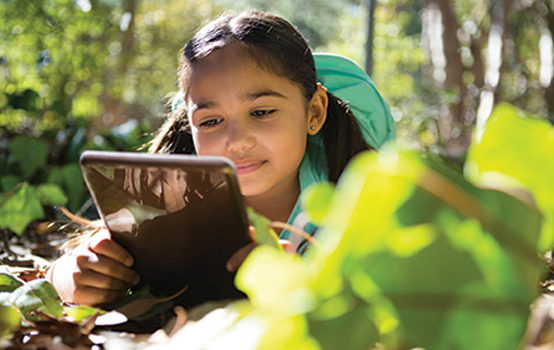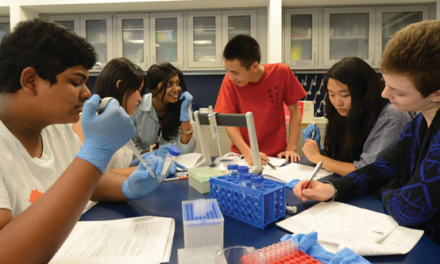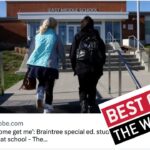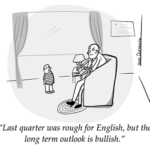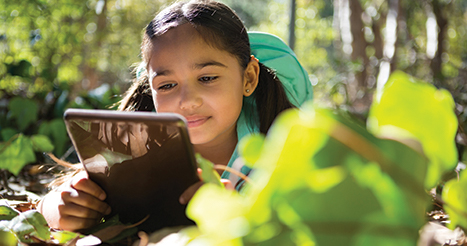
What kind of literacy instruction can prepare young people to navigate the online world? Schools should teach their students to be generalists, say the authors.
Today, information is both easier to access and harder to evaluate than ever before. As the philosopher Michael Patrick Lynch (2016) has argued, the internet’s influence on learning and communication has been even more profound than the invention of the printing press; he suggests that a more apt comparison would be to the invention of the written word itself:
The internet is bringing about a similar revolution in our ways of knowing. Where the written word allows us to time-travel, the internet allows us to teleport — or at least to communicate in an immediate way across spatial gulfs . . . Today, the fastest and easiest way of knowing is Google-knowing, which means not just “knowledge by search engine” but the way we are increasingly dependent on knowing via digital means. (pp. xv-xvii)
How do we prepare students for this new reality when many of us are struggling to understand it ourselves? As literacy educators and classroom researchers, we have, at times, felt overwhelmed by the task. Is it even possible to teach young people to be independent readers and writers at a time when anonymous web designers can and often do take deliberate steps to manipulate the public’s access to information (a process that former Google ethicist Tristan Harris, 2016, described as “hijacking” our minds)? How can we teach students to find credible sources when even the most well-respected news media, such as the New York Times, are just a few links away from an array of fake and biased sites (Albright, 2016)? And how can our democracy survive when fewer and fewer people trust the work of mainstream journalists (PEN America, 2017)?
This is a unique moment in history, one that is filled with daunting challenges for teachers. But we also see opportunities, and we are resolved to pursue them. As Stanford University’s Sam Wineburg has argued, we’re in the midst of a “revolution,” and we have to “think hard about what the school curriculum really needs to look like in an age when we come to know the world through a screen” (Dyer, 2017).
We agree with Wineburg’s call to action, and we know many other teachers who want to take up this charge. The question is, how should we define the goals of literacy instruction today? Decades of research in a range of literacy fields certainly can provide us with direction. For example, we can look to the research on critical literacy (e.g., Freire, 1970), media literacy (e.g., Hobbs, 1998), new literacies (e.g., Coiro et al., 2008), multiliteracies (e.g., The New London Group, 1996), or disciplinary literacy (e.g., Moje, 2015). But an even older perspective may also provide useful insights into how best to teach children to live in a digital age.
Lewis Mumford and the case for the generalist
Lewis Mumford was known for his work as a historian, sociologist, literary critic, and city planner. But while he was honored and respected in each of these fields, he embodied and advocated for the important role of the “generalist,” one whose talent lay “not in unearthing new evidence but in putting together authentic fragments that are accidentally, or sometimes arbitrarily, separated, because specialists tend to abide too rigorously by a gentlemen’s agreement not to invade each other’s territory” (Mumford, 1966, p. 46). In short, he made it his mission to travel among professional silos, making connections across disciplines and fields.
At the center of Mumford’s concept of the generalist is a respect for specialists’ expertise. The generalist depends on disciplinary experts and must be ready to
scrap any piece of evidence, however he may cherish it, as soon as one of his specialist colleagues discovers that it is suspect, or that it does not fit into the particular environment or the particular time sequence under discussion. When not enough parts exist, the generalist must wait until competent authorities find or fabricate them. (pp. 46-47)
This doesn’t mean that a generalist must accept as true everything that a specialist says. Mumford took a cautious approach toward research findings, always trying to understand what counts as evidence in a given field. In our understanding, generalists ask two important questions of experts: “What would make you change your mind?” and “From your perspective, how big a deal is this?”
Despite his cautious approach, Mumford did insist that specialists make uniquely valuable contributions to humanity’s collective body of knowledge, and he would have been greatly troubled to see how Americans’ respect for experts and their role in society has eroded in recent years (Nichols, 2017).
As Eva Thomm and Rainer Bromme (2012) have argued (writing specifically about scientific information), given the sheer quantity of information available in the 21st century, citizens have no choice but to “off-load” some responsibility for judging whether certain information is credible:
Being aware about the difference between one’s own knowledge and experts’ knowledge about topics of common interest is important for coping with the division of cognitive labor in modern societies, requiring everybody to rely on specialized experts and their expertise. (p. 207)
Of course, there are better and worse ways to do this. For example, to understand the implications of rising global temperatures, it makes better sense to rely on a climate scientist from a major university than a spokesperson for the oil and gas industry (or a friend and her Facebook news feed). Further, it’s important to stay engaged over time with specialized topics, since expert understandings are always subject to revision. Particularly when it comes to science, the public often struggles to understand that “credible” doesn’t mean “true for ever and ever.” Finally, it’s important to look across disciplinary fields to understand issues, recognizing that different kinds of expertise may be relevant to a single situation.
We argue that the goal of becoming a generalist, as Mumford defined it, offers a good model for literacy education at a time when Americans live much of their lives online. Yet, we know that it’s no simple matter to teach students to be generalists. As noted above, the generalist both respects and questions experts and expertise — and that’s a complex endeavor for both young people and the adults who teach them. Generalists don’t simply defer to authorities, accepting everything that they hand down as truth; nor do they reject expert knowledge or claim that their personal opinions are just as valid.
In short, becoming a generalist requires a kind of balancing act. Students need to develop a basic understanding of how claims are made and defended in various fields; they need foundational knowledge in a variety of content areas (or, at a minimum, an understanding of where to find that knowledge when they want it); and they need to understand how information travels from its original source (whether it be a research lab, a partisan think tank, or a teenager’s basement) to the general public.
Generalists don’t simply defer to authorities, accepting everything that they hand down as truth; nor do they reject expert knowledge or claim that their personal opinions are just as valid.
Becoming an expert information seeker
As James Gee (2017) and other scholars of literacy have long argued, students’ learning and literacy practices are always intertwined with their efforts to shape an identity — i.e. to decide what kind of person they want to be. As identities go, “generalist” is a bit vague, though. Instead, we recommend that teachers encourage students to identify themselves as “expert information seekers,” similar to librarians, journalists, and writers of nonfiction books.
After conducting numerous interviews with professionals in each of these fields, we concluded that they share several characteristics. These expert information seekers:
- Keep an open mind, putting aside their personal opinions when trying to learn about a topic or understand a point of view;
- Always look for multiple sources of information (for corroboration) and multiple perspectives (for contextualization) on important topics;
- Understand who experts are and how to find them;
- Recognize differing kinds of sources and types of expertise; and
- Know that learning about an important topic will require searching broadly, reading carefully, and being patient and persistent.
In the digital age, it can be difficult to follow these practices. Given that the information landscape is constantly changing, how can one be sure that the sources and experts one finds truly represent a range of perspectives and types of expertise? After all, the algorithms search engines use are proprietary; new sites appear regularly, and both users and designers can manipulate the content that appears on sites such as Reddit, Google, and Facebook.
Despite all these challenges, educators can and must help their students become skilled at navigating the digital landscape. Most important, they can teach them to look for the sources of the information that appears on their screens. To some extent, the information landscape varies by discipline, but it’s easy to recognize some common patterns within each field. For example, information tends to move much more slowly and predictably in scientific fields than it does in popular media coverage of current events. Typically, in the sciences, a team of researchers in a university laboratory will conduct a series of experiments and conclude that the results are potentially important. That information will likely appear first in a peer-reviewed journal article, which may be summarized in a press release by the university’s public relations department. In turn, that press release may get posted to the university website and to a press release aggregator (such as eurekalert.org). From there, the story gets somewhat more complicated, as some news sites may report on the press release (or reproduce it verbatim) while other print, web, and television outlets may do additional reporting, often by asking other experts to contextualize and comment on the importance of the work.
In media coverage of current events, the event itself may be the initial starting point, with a flurry of social media posts and stories coming next, followed by newspaper articles (which, ideally, will have multiple credible sources including both experts and stakeholders), magazine stories, and eventually, if the event is deemed important enough, academic research articles and books. (In the field of library science, this process is often called the “information life cycle.”)
The ability to track a story from a news feed back to its original source — be it a university laboratory, the newsroom of the Wall Street Journal, or the shadowy world of “fake news” — is a generalist skill that all young people ought to acquire. Every student should learn that if the trail goes cold before they’ve found a credible source, alarm bells should ring.
The ability to track a story from a news feed back to its original source is a generalist skill that all young people ought to acquire.
It can be challenging to track information across the complex landscape of the web. In our work in schools, we’ve often seen teachers try to strengthen this skill by requiring students to use “multiple sources” of information for papers or reports. Similarly, in a recent TED talk, journalist Ali Velshi (2017) suggested that people “triangulate” their news information, looking for at least three sources. However, students don’t always recognize the distinction between multiple sources and multiple independent sources. Plus, it has become harder and harder to find a range of independent reports on any given story. In recent years, the number of journalists — people who actively research their stories using multiple sources — has declined dramatically across the country, as newspapers have gone out of business and the market for online journalism has plateaued (Williams, 2016). Further, and as we’ve heard from several librarians, since digital natives may have never seen the analog versions of digital publications — e.g., a physical newspaper or a hard copy of an academic journal — they may not even know what different types of sources look like.
Students don’t always recognize the distinction between multiple sources and multiple independent sources.
Nor do students necessarily recognize the difference between a news aggregator (which links to a news story) and a newspaper (which publishes original reporting), or between a news report (which includes multiple sources of information) and a press release (which presents only one perspective). Also, the distinction between press releases and journalism is quickly becoming fuzzy because many “news sites” now publish press releases with no additional reporting, a process dubbed “churnalism” (Moore, 2011). In short, the “three sources” that students cite may actually be a single press release that has been repurposed and reposted by multiple websites.
For an expert information seeker, this won’t do. As Lewis Mumford might have argued, citizens of the digital world cannot rely on second- or thirdhand information, or even on professional journalism alone. Rather, they must have the capacity to engage directly with the specialists who produced the information in the first place and who have legitimate expertise in that area. Teachers who wish to cultivate a generalist identity in their students must understand something about this landscape themselves, and they must take it upon themselves to steer their students to those places on the web where the experts can be found.
When everyone is a skeptic
In addition to conducting interviews with expert information seekers, we have also interviewed average Americans about their information-seeking practices. Across all participants, we hear a common refrain: No one wants to admit to being fooled online; everyone wants to be known as a “skeptic.”
And yet, we know just how easy it is to be misled by information online. The time is ripe to rethink information literacy in schools, but we must start by admitting that we face great challenges. Developing more “credibility checklists” or updating school “rules” for internet searches will not prepare students for the reality of the 21st century. Educators must be more ambitious than that, modeling for their students not only what to do but how to be in the world of information.
References
Albright, J. (2016, November 18). The #election2016 micro-propaganda machine. Medium.
Bromme, R. & Goldman, S.R. (2014). The public’s bounded understanding of science. Educational Psychologist, 49 (2), 59-69.
Coiro, J., Knobel, M., Lankshear, M., & Leu, D.J. (Eds). (2008). Handbook of research on new literacies. New York, NY: Taylor and Francis.
Dyer, J. (2017, April 14). Can news literacy be taught? Nieman Reports.
Freire, P. (1970). Pedagogy of the oppressed. New York, NY: Continuum.
Gee, J. P. (2017). Teaching, learning, literacy in our high-risk high-tech world: A framework for becoming human. New York, NY: Teachers College Press.
Harris, T. (2016, May 19). How technology hijacks people’s minds: From a magician and Google’s design ethicist. From www.tristanharris.com
Hobbs, R. (1998). The seven great debates in the media literacy movement. Journal of Communication, 48 (2), 9-29.
Lynch, M.P. (2016). The internet of us: Knowing more and understanding less in the age of big data. New York, NY: Liveright Publishing.
Moje, E.G. (2015). Doing disciplinary literacy with adolescent learners: A social and cultural enterprise. Harvard Educational Review, 85 (2), 254-278.
Moore, M. (2011, March 3). Churnalism exposed: A new website identifies press release copy in the news. Columbia Journalism Review.
Mumford. L. (1966). Speculations on prehistory. The American Scholar, 36 (1), 43-53.
New London Group. (1996). A pedagogy of multiliteracies: Designing social futures. Harvard Educational Review, 66 (1), 60-92.
Nichols, T. (2017). The death of expertise: The campaign against established knowledge and why it matters. New York, NY: Oxford University Press.
PEN America. (2017). Faking news: Fraudulent news and the fight for the truth. New York, NY: Author.
Thomm, E. & Bromme, R. (2012). ‘It should at least seem scientific!’: Textual features of ‘scientificness’ and their impact on lay assessments of online information. Science Education, 96 (2), 187-211.
Velshi, A. (2017). In an age of “alternative facts,” how do we know what’s true? The TED Radio Hour. National Public Radio.
Williams, A.T. (2016, September 27). Employment picture darkens for journalists at digital outlets. Columbia Journalism Review.
Originally published in March 2018 Phi Delta Kappan 99 (6),33-38. © 2018 Phi Delta Kappa International. All rights reserved.
ABOUT THE AUTHOR

E. Wendy Saul
E. WENDY SAUL is Founder’s Professor at the University of Missouri-St. Louis.

